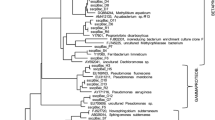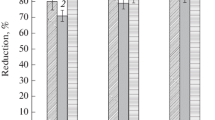Abstract
A radioactive liquid waste repository was found to be the habitat of a rich microbial community with a high catabolic potential. Groundwater from a depth of 162–189 m contained aerobic saprotrophic and anaerobic fermentative, sulfate-reducing, and denitrifying bacteria. Nitrate-reducing bacteria residing in this groundwater were isolated in pure cultures. Based on the results of their physiological studies, 16S rRNA sequencing, and phylogenetic analysis, the microorganisms isolated were ascribed to one phylogenetic branch, the γ-subclass of gram-negative bacteria. Among six isolates, four belonged to the genusAcinetobacter, whereas two others belonged to the generaComamonas andAeromonas. The data obtained indicate that the microflora of the repository can exert a certain effect on the chemical composition of the formation fluids and bearing rocks, as well as on the migration of radionuclides
Similar content being viewed by others
References
West, J.M., McKinley, I.G., and Chapman, N.A., Microbes in Deep Geological Systems and Their Possible Influence on Radioactive Waste Disposal,Rad. Waste Management Nuclear Fuel Cycle, 1982, vol. 3, pp. 1–15.
West, J.M., Christofi, N., and McKinley, I.G., An Overview of Recent Microbiological Research Relevant to the Geological Disposal of Nuclear Waste,Radioact. Waste Manage. Nucl. Fuel Cycle, 1985, vol. 6, no. 1, pp. 79–95.
West, J.M., McKinley, LG., Grogan, H.A., and Arme, S.C., Laboratory and Modelling Studies of Microbial Activity in the Near Field of the HLW Repository,Mater. Res. Soc. Symp. Proc, 1985, vol. 50, pp. 533–538.
Pedersen, K., Arlinger, J., Ekendahl, S., and Hallbeck, L., 16S rRNA Diversity of Attached and Unattached Bacteria in Boreholes along the Access Tunnel to the Aspo Hard Rock Laboratory, Sweden,FEMS Microbiol. Ecol., 1996, vol. 19, pp. 249–262.
Stroes-Gascoyne, S. and West, J.M., Microbial Studies in the Canadian Nuclear Fuel Waste Management Program,FEMS Microbiol. Rev., 1997, vol. 20, pp. 573–590.
Pedersen, K., Investigation of Subterranean Bacteria in Deep Crystalline Bedrock and Their Importance for the Disposal of Nuclear Waste,Can. J. Microbiol., 1996, vol. 42, pp. 382–391.
Pedersen, K., Microbial Life in Deep Granite Rock,FEMS Micmbiol. Rev., 1997, vol. 20, no. 3/4, pp. 399–414.
McKinley, I.G., Hagenlocher, I., Alexander, W.R., and Schwyn, B., Microbiology, in Nuclear Waste Disposal: Interfaces and Reaction Fronts,FEMS Microbiol. Rev., 1997, vol. 20, no. 3/4, pp. 545–556.
Humphreys, P., McGarry, R., Hoffmann, A., and Binks, P., DRINK: A Biogeochemical Source Term Model for Low Level Radioactive Waste Disposal Sites,FEMS Microbiol. Rev., 1997, vol. 20, no. 3/4, pp. 557–572.
Kuznetsov, S.I. and Dubinina, G.A.,Metody izucheniya vodnykh mikroorganizmov (Methods for Studying Aquatic Microorganisms), Moscow: Nauka, 1989, pp. 146–148.
Postgate, J.R.,Sulfate-Reducing Bacteria, Cambridge: Cambridge Univ. Press, 1984, 2nd edition.
Adkins, J.P., Cornell, L.A., and Tanner, R.S., Microbial Composition of Carbonate Petroleum Reservoir Fluids,Geomicrobiol. J., 1992, vol. 10, no. 2, pp. 87–97.
Trüper, H.G. and Schlegel, H.G., Sulphur Metabolism inThiorhodaceae: I. Quantitative Measurements on Growing Cells ofChromatium okenii, Antonie van Leeuwenhoek, 1964, vol. 30, no. 3, p. 225.
Reznikov, A.A., Mulikovskaya, E.P. and Sokolov, I.Yu.,Metody analiza prirodnykh vod (Analytical Methods for Natural Waters), Moscow: Nedra, 1970.
Marmur, J., A Procedure for the Isolation of DNA from Microorganisms,J. Mol. Biol., 1961, vol. 3, pp. 208–218.
Owen, R.J., Hill, L.R., and Lapage, S.P., Determination of DNA Base Compositions from Melting Profiles in Dilute Buffers,Biopolymers, 1969, vol. 7, p. 16.
Edwards, U., Rogall, T., Bloeker, H., Ende, M.D., and Boeettge, E.C., Isolation and Direct Complete Nucleotide Determination of Entire Genes, Characterization of Gene Coding for 16S Ribosomal RNA,Nucleic Acids Res., 1989, vol. 17, pp. 7843–7853.
Van de Peer, Y. and De Wachter, R., TREECON for Windows: A Software Package for the Construction and Drawing of Evolutionary Trees for the Microsoft Windows Environment,Comput. Appl. Biosci, 1994, vol. 10, pp. 569–570.
Rainey, F.A., Lang, E., and Stackebrandt, E., The Phylogenetic Structure of the GenusAcinetobacter, FEMS Microbiol. Lett., 1994, vol. 124, pp. 349–353.
Nishimura, Y., Ino, T., and Iizuka, H.,Acinetobacter radioresistens sp. nov. Isolated from Cotton and Soil,Int. J. Syst. Bacteriol, 1988, vol. 38, no. 2, pp. 209–211.
Collins, M.D., Martinez-Murcia, A.J., and Cai, J.,Aeromonas enteropelogenes andAeromonas ichthiosmia Are Identical toAeromonas trota andAeromonas veronii, Respectively, as Revealed by Small-Subunit rRNA Sequence Analysis,Int. J. Syst. Bacteriol., 1993, vol. 43, pp. 855–856.
Towner, K.J., The GenusAcinetobacter, The Prokaryotes, Balows, A. et al., Eds., New York: Springer, 1999, pp. 3137–3143.
Author information
Authors and Affiliations
Rights and permissions
About this article
Cite this article
Nazina, T.N., Kosareva, I.M., Davidov, A.S. et al. Physicochemical and microbiological characteristics of groundwater from observation wells of a deep radioactive liquid waste repository. Microbiology 69, 89–95 (2000). https://doi.org/10.1007/BF02757263
Received:
Issue Date:
DOI: https://doi.org/10.1007/BF02757263




